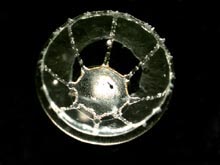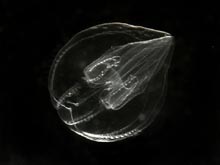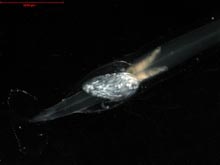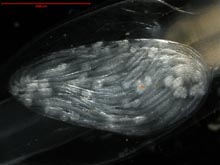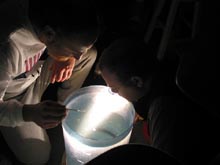
In search of more gelatinous organisms, Russ Hopcroft of the University of Alaska Fairbanks and Kevin Raskoff of MBARI peer into a recently collected net tow sample. (Photo by Jenny Steinberg, National Geographic Society.) Click image for larger view.
Highlights of Pelagic Fauna
August 14 - September 8, 2002
Dr. Russ Hopcroft
University of Alaska, Fairbanks
 Experience a close encounter with a Chyrsaora jellyfish.
Experience a close encounter with a Chyrsaora jellyfish.
 Watch a slideshow of some fascinating invertebrates found in the Arctic.
Watch a slideshow of some fascinating invertebrates found in the Arctic.
In order to maximize our exploration of the zooplankton communities in the Canada Basin, we used a combination of a specialized plankton net routinely deployed to 500 m depth, scuba divers collecting in the surface waters, and the remotely operated vehicle (ROV) to reach depths of up to 2,800 m.
We documented many gelatinous organisms throughout our cruise track. We collected specimens of ctenophores, hydromedusae and siphonophores in bongo and live net vertical hauls. Our diving team collected many ctenophores at depths of <40 ft, and observed large scyphomedusae in the surface waters. We succeeded in making video and still camera records of many gelatinous species from the ROV during 2 test dives, 2.5 pelagic dives and 2.5 benthic dives. A wide range of living specimens were photographed and preserved for further documentation and for molecular identification. At present, we are confident that one specimen of a narcomedusae collected by the ROV in the first pelagic dive appears to be a new species.
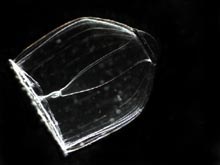
From top to bottom: The hydomedusae Aglantha digitale, Botrynema ellinorae, and juvenile Bolinopsis ctenophore. (Photos by Kevin Raskoff, MBARI.) Click image for larger view.
Most other gelatinous groups that are normally common in the oceans were not well represented in the Arctic. The pelagic tunicates were only visible as two or three species of larvaceans; the absence of salps and doliolids is unusual. Pelagic polychaetes are routinely present in the plankton, but with the exception of a few meroplanktonic forms, they were not present in any of the collections, nor observed from the ROV. Low numbers of chaetognaths, almost entirely comprised of Eukrohnia hamata, occurred in all nets and were observed throughout the water column by the ROV. During the cruise, we discovered that the species lays an egg sack that is held in a marsupium until hatching.
Although no cephalopods were observed on any ROV dive, given the very low abundances of all types of organisms studied during the cruise, it is not surprising that predators such as cephalopods are few and far between. Many fishes were sometimes encountered, particularly in the Northwind Basin, indicating that within the habitats with numerous fishes the ecological importance of cephalopods appears to be low. The only pelagic mollusk observed during the cruise were low numbers of two pteropod species.
There were no surprises in terms of the crustacean zooplankton that normally represent the bulk of zooplankton throughout the world's oceans. Net hauls were dominated in terms of biomass by adults of the copepod Calanus hyperboreus, which appeared to be concentrated in the upper 100 m, and possibly concentrated close to the ice.
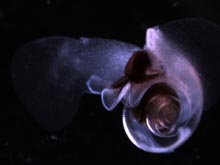
A pelagic pteropod collected during one of the net tows. (Photo by Russ Hopcroft, University of Alaska Fairbanks.) Click image for larger view.
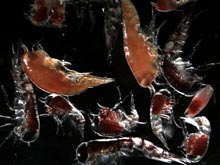
This amalgam of amphipods hints at the diversity of species scientists can find in the Arctic. (Photo by Russ Hopcroft, University of Alaska Fairbanks.) Click image for larger view.
In terms of abundance, small species of copepods dominated, most notably the genus Oncaea, followed by Oithona similis and Mormonilla sp. The importance of these smaller species is not currently appreciated. Between one and two dozen other copepod species were observed, but at least one genus reported to be abundant in the Arctic, Pseudocalanus, was only rarely observed in the samples. One species of shrimp, Hymendora glacialis, was colleted by the nets and the ROV. A total of 4 species of amphipods were encountered; the deeper-water species (as yet unidentified) was readily attracted to the lights of the ROV, allowing for the easy collection of specimens by the ROV’s suction sampler. A single species of ostracod occurred commonly in the plankton net collections.
All our observations indicated that distinct depth layering of zooplankton occurs throughout the water column. This is likely related to the distribution of algae biomass against the ice and in the water column immediately below it. Herbivorous copepods are concentrated in the near surface waters, and preyed on by the abundance of ctenophores in that layer. The ctenophores, in turn, are preyed upon by a layer of large scyphomedusae just below them. Smaller hydromedusae, such as Botrynema ellinorae and Aglantha digitale, are scattered from the surface to a layer of “Atlantic” water characterized by siphonophores at 350-400 m. Mesopelagic hydromedusae, most notably Sminthea arctic, and the schyopmedusae Atolla tenella, occur below this.
For more information regaring the Pelagic Ecological Group, see the August 22 and August 31 log entries.
The chaetognath Eukrohnia hamata with an egg sac held in its marsupium. Scientists were able to observe and document the juveniles "hatching." (Photo by Russ Hopcroft, University of Alaska Fairbanks.) Click image for larger view.
Sign up for the Ocean Explorer E-mail Update List.



























